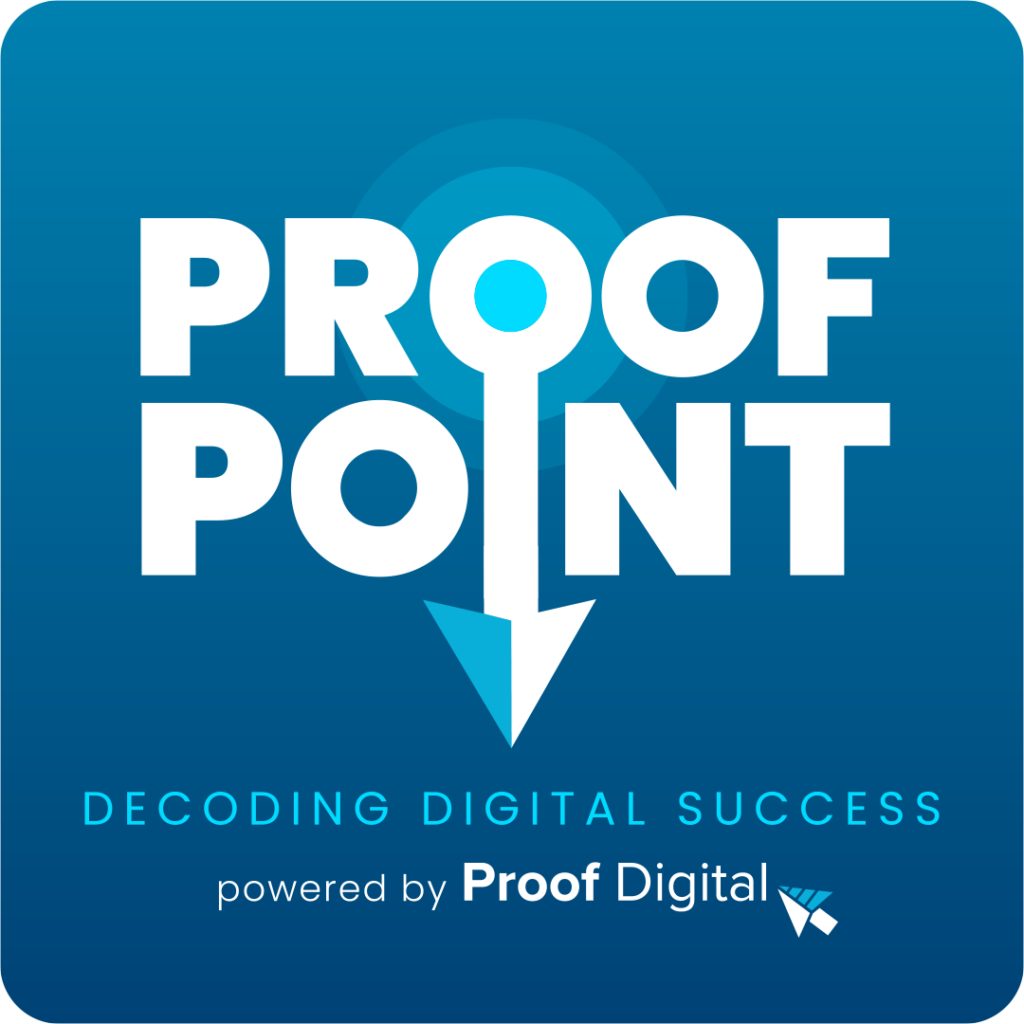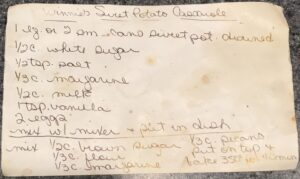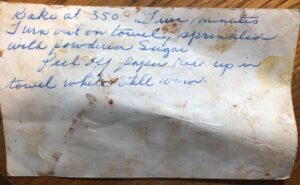
Stacie Porter Bilger is the Founder and President of Proof Digital, a business growth-marketing agency that blends modern marketing tools with traditional sales funnel processes. She spent the first 20 years of her career working with businesses to strategize development and connect them to investors. Before founding Proof Digital, Stacie worked for several Chambers of Commerce and startups like the Indiana Venture Center.
Here’s a glimpse of what you’ll learn:
- Why Blackburn Manufacturing started working with Proof Digital
- The importance of building trust in a business relationship
- How Blackburn Manufacturing went from zero to making millions with Proof Digital
- What did Proof Digital do to improve the search ranking for YOURspace?
- How does Proof Digital approach rebranding clients’ websites?
- Who should contact Proof Digital?
In this episode…
It takes unique insights, strategies, and know-how to drive growth in the digital space. To grow your website, you must focus on data-driven tactics to get tangible results that will enhance your online presence. How can businesses leverage the latest digital marketing techniques and web development strategies to optimize their website and achieve lasting success?
As a seasoned performance marketer, Stacie Porter Bilger believes it all boils down to data analysis, A/B testing, and competitor research. By meticulously analyzing data, businesses can uncover valuable insights about their target audience’s behavior and preferences to tailor their marketing strategies for maximum effectiveness. Implementing A/B testing allows businesses to experiment with different approaches and identify what yields the best results, optimizing conversion rates and driving growth. Furthermore, conducting thorough competitor research provides valuable insights into market trends and consumer expectations, empowering businesses to stay ahead of the competition and seize new opportunities. Companies can enhance their digital marketing efforts and achieve tangible results by leveraging data, conducting A/B testing, and staying informed about competitors.
In this episode of the Proof Point podcast, Chad Franzen of Rise25 sits down with Stacie Porter Bilger, the Founder and President of Proof Digital, to talk about what it takes to grow your business online. Stacie discusses the importance of building trust in a business relationship, how Proof Digital helps its clients, and who should reach out to Proof Digital for help.
Resources mentioned in this episode:
- Proof Digital
- Stacie Porter Bilger on LinkedIn
- Dr. Jeremy Weisz on LinkedIn
- Chad Franzen on LinkedIn
- Rise25
- Blackburn Marking Flags & Marking Products
- YOURspace
Sponsor for this episode…
This episode is brought to you by Proof Digital.
We are a strategic and creative performance marketing agency partnering with organizations to create data-fueled marketing engines that drive growth and deliver a tangible ROI.
Founded by Stacie Porter Bilger in 2012, Proof Digital employs a strategic marketing approach by blending today’s marketing tools like SEO, PPC, and paid social ads with traditional sales funnel processes.
Ready to get results? Visit https://proofdigital.com/ to learn more.
Interview Transcription – Decoding Digital Success
(0:02 – 0:16)
Welcome to the Proof Point Podcast, where we decode digital success, one click at a time. We share key takeaways fueled by data and insights that your team can implement today to drive growth. Now, let’s get started.
(0:21 – 0:53)
Hi, it’s Stacie Porter-Bilger, your host with the Proof Point Podcast, where I feature B2B and D2C businesses and thought leaders sharing marketing, data tactics, sales strategies to kickstart growth in a rapidly changing digital space. The podcast today is brought to you by Proof Digital. Proof Digital is a strategic and creative performance marketing agency partnering with companies to create data-fueled marketing campaigns and tactics that drive growth and deliver tangible ROI.
(0:54 – 1:09)
Ready for results? Visit proofdigital.com to learn more. Today, I want to, first, before we get going, I want to do a shout-out to Jeremy Wise, who introduced me to Chad, and it’s been a pleasure working with Jeremy along the way here. Chad, welcome.
(1:10 – 1:24)
Chad is with Rise25, who’s done thousands of interviews with successful entrepreneurs and CEOs. Today, we’re going to actually flip the script, and he’s going to interview me today. So, Chad, thanks so much for joining me.
(1:24 – 1:29)
I really appreciate you giving me your time today. Yeah, absolutely. Thank you so much, Stacie.
(1:29 – 1:46)
It’s great to be here. I think today we’ll talk about maybe some clients that Proof Digital has had, and some things that you did would come, why a company like them would come to you, things like that. So, as we get started here, I know there’s one that’s kind of a marking flag company.
(1:46 – 2:08)
Can you tell me about who they are and how they found you? Blackburn Marking Flags, Blackburn Manufacturing. They’re out of Nebraska and a fabulous family-owned company. They’ve been in business 70-plus years.
(2:08 – 2:21)
Their grandfather actually invented the flag machine. For surveyors, there was a problem to be solved. A surveyor needed to mark the ground before digging.
(2:21 – 2:38)
They created a machine, and now, 70 years later, you have Blackburn Flag. Well, actually, we found them, to be truthful in this particular case. We work with manufacturing companies, and this was probably back in 2015-ish.
(2:39 – 2:57)
So, we’ve been working with them seven, eight years. And they, we just came across, we wanted to work with manufacturing companies, and we reached out to them and had a conversation, and they hired us. And we haven’t looked back, and nor have they.
(2:58 – 3:17)
So, what was the issue or situation that kind of, that they were in that caused you to think that they would be a good group to work with? Well, one, their site was a mess. It looked like it was not secure. Their site was not telling their story.
(3:17 – 3:33)
It was not set up for e-commerce sales, although it was an e-commerce site. So, there was a lot of issues we saw with the site, and we saw the market had a huge opportunity. And so, when we looked at them and said, okay, they’re missing out here, and how can we help them? So, we reached out and said, hey.
(3:34 – 3:42)
And then, the other thing was, they had a web development partner who was not really a partner. The site was broken. They were not responsive.
(3:42 – 3:54)
So, they were definitely motivated to find a partner the same time when we were looking at them. So, it was like, they were looking for dating, and we were dating too. So, we kind of connected at the right moment in time.
(3:55 – 4:11)
Perfect. And we’ve kept them as a partner and will continue for a long time. I’m sure, given their experience with the prior individual they were working with, they were, while they were probably excited to find a new company, they were probably maybe a little bit skeptical.
(4:12 – 4:26)
What were some concerns that they had at the beginning? You know, it’s, anytime you’re working with another company, it’s about building trust. And we just had a great conversation, and we were honest with them. And we started slow too.
(4:27 – 4:40)
It’s not like we jumped in and started doing everything. We started slow. So, we started with, you know, getting control of their web presence and building a site for them that actually was something to grow on.
(4:40 – 4:56)
And so, we started slow. And I think, you know, when you’re honest and you see and listen to what their challenges were and being responsive, that’s a good way to start. And one of their also just really good people.
(4:57 – 5:03)
We love working with them. Every time I get on a phone call with them, it’s a joy. That’s great.
(5:03 – 5:14)
So, take me through like where they were at. You kind of described their situation and then what you did for them and where they are now. Yeah.
(5:14 – 5:25)
Well, they were making zero dollars basically on their e-commerce site. Zero, just basically from ground zero. And they didn’t have control again of their marketing presence.
(5:26 – 5:38)
Now they’re competing in ranking for thousands and thousands of keywords. So, we worked on what’s a technique called SEO, search engine optimization, but we did ads. We did brand development.
(5:39 – 5:58)
We built their site on an e-commerce platform. So, those are things we did. And where they’re at now is now they’re selling millions of dollars online and competing against the big box markets, Lowe’s, Amazon, Home Depot, all those particular markets online.
(5:58 – 6:18)
And if you’re looking for a marking flag, a custom marking flag, signage, marking tape, you’ll find them. Wow, that is an amazing outcome. What do you think was like the, was there something that really turned the tide for them? I mean, was it just do your thing and it worked? Well, no, you don’t.
(6:18 – 6:52)
I mean, things take time, but the first thing is you had to have a, they had to have a web structure, a website that one was scalable and one easy for them to use and integrate with their systems. And so the big thing is they needed one, a website that gave a user experience. From there, we can build and grow some of those other tactics of how to penetrate particular customers in certain industries, which we continue to do and continue to grow with them, but you need to have a good foundation.
(6:53 – 6:58)
And that was a starting point. Okay, great. Hey, let’s talk about one more.
(6:59 – 7:04)
Yeah, okay. It’s called YOURspace. Tell me who they are and what they do, things like that.
(7:04 – 7:21)
Yeah, they’re a young company out of Fort Wayne, Indiana. They came to us actually from a referral in this particular case. Someone, another client who we work with, connected them to us.
(7:22 – 7:33)
They gave us a call and said, hey, we want to start this company. And they, I mean, it was the middle of the pandemic. So it was like the spring, no, fall of 2020.
(7:34 – 7:48)
They were building to solve a problem. They do privacy pods, they do education pods, they do office pods. Basically with office fit-outs in offices and how they’ve changed.
(7:48 – 8:14)
It was bringing some privacy and some options to scale or build out a business space without having to put a whole lot of capital involved. And so, and obviously with the pandemic at the time too, privacy and having office space that was, you know, enclosed was also important. So we built a site really rapidly actually.
(8:14 – 8:27)
I think the site was up in four or five weeks. We started with the baseline from a standpoint of so we built out a site. Then we looked at their competitor, which was room.com, which was a massive company.
(8:27 – 8:37)
They just got bought by a large player as of the last couple of months ago. But they’re spending millions of dollars in this space. And obviously, the startup did not have that.
(8:37 – 9:00)
So you look at their weaknesses to be truthful. You looked at room.com, where were they? Where did they need to, where were they not playing? Where were some areas in which we can build copy and build a strategy around getting some visibility in some of those markets that they were vulnerable in? And we did. Now they rank for thousands of keywords as well.
(9:00 – 9:26)
We did ads. We did a whole strategy, kind of go-to-market strategy with them in the digital space, especially during the pandemic, because that was really the only place they were getting leads because we weren’t doing any face-to-face marketing. So now they, if you look, education pods, sensory pods, airport pods, library pods, they’re in libraries, they’re in medical facilities.
(9:27 – 9:37)
Now they’re doing office fit-outs, working with architects. So they’re growing, but they went into, and we penetrated some markets that their competitor was vulnerable on. And so they’re doing great.
(9:38 – 10:02)
We also, from a standpoint now, we launched that site quickly in 2020. We just did a whole new rebrand because we learned some things about the market and just launched a new site for them here in the last couple of weeks. So to really better tell their story and also their business model, better represent how they want people to engage with them when they do come to their site.
(10:03 – 10:18)
I mean, you have a quick-ship option. So if you need something that’s kind of really quick or if you want something custom, so it’s kind of driving the consumer in a way that best they can serve. It sounds like the pandemic, I guess, was kind of helpful in this situation to find this client, to work with this client.
(10:19 – 10:33)
Did working during the pandemic present any challenges in this case? Not in this case. I mean, Proof Digital, we’ve always been, we were ahead of the game on that. We’ve been built to work from anywhere for a long time.
(10:33 – 10:58)
We have a physical office in Indianapolis, but we also have team members across the United States. And so we were already set up to be able to move quickly and rapidly. The main challenge, although with Zoom these days, was, okay, what are their goals? I mean, getting in the imagery and pictures and those types of things were always a little bit more challenging during that peak time, because we need to have, be able to tell the story of the product.
(10:58 – 11:05)
But we got through that. And obviously, they’re kind of going to the next level right now and they’re doing great. Great.
(11:06 – 11:19)
Is it pretty common for Proof Digital, you mentioned you did kind of a reprint for their website based on, new things you learned about the market or whatever. Is that pretty common? Is that something that’s pretty common that you guys do? Yeah. Yeah, we do.
(11:20 – 11:35)
One, we definitely leverage data, but we have, from that data, you understand consumer behavior. We’ve used data on sites, for example, of where people are spending time and how they behave, and how they react to something. You do A-B testing to see, okay, this image is better than this image.
(11:35 – 11:49)
By learning, we actually will do, and the whole new rebrand of the site you’ll, it’s also more engaging. It’s actually more user-friendly. So by learning, we kind of go to the next level.
(11:49 – 11:58)
Once the client’s ready, obviously this was a startup. They couldn’t go from, to the level it’s at currently where they’re at now, but now they can. So you kind of grow and learn.
(11:58 – 12:38)
So we do that. So as we kind of wrap things up here, can you tell me, these two clients that we used as an example today, obviously benefited greatly from your services. Can you tell me what other, maybe without mentioning the clients, maybe situations that people or businesses have that would be beneficial for them to reach out to Proof Digital? Yeah, I mean, similar, not knowing where to start, right? That’s an issue from a marketing standpoint.
(12:38 – 12:51)
They don’t know where to start. And from a standpoint of finding quick wins in the YOURspace example, that’s what we do. Not everybody wants to, they want quick ROI.
(12:52 – 13:26)
They don’t want to spend tons of money on marketing with that result. So if they have been in that situation where they’re not seeing a good ROI or they’re not seeing results or know what their marketing dollars are doing in today’s day and age, there’s no reason for that. So if a company really wants to know how to spend their marketing dollars wisely, how to build a site that actually is built correctly, and that was the case with both YOURspace and Blackburn where their site was not built correctly.
(13:26 – 13:43)
And in today’s world, there’s three important things. I mean, there’s lots of things, but if you kind of down, kind of sum it up, you need a house that doesn’t have leaky faucets in the back of, in fire hazards of a house, and that’s your website. You need content that tells your story and you need to get people to actually engage with you.
(13:44 – 14:01)
So those are things if you’re looking for that. What’s kind of a common fire hazard in terms of the house? Yeah. Well, somebody will build a site and there’s not, there’s broken code, there’s broken links on a site.
(14:03 – 14:09)
Google can’t crawl your site. There’s all kinds of errors and coding errors on a site. I mean, that’s the foundation.
(14:09 – 14:27)
I mean, your site is your business. And if you have, plumbing that’s not hooked up, you’re gonna have a water leak and then Google will punish you for that or your consumers will because they’ll leave your site. So those are kind of the, those are the fire hazards.
(14:27 – 14:36)
You wanna make sure that you have a sound, a structural site that Google knows what you do. Okay. That’s very good to know and very important to stay on top of.
(14:37 – 14:42)
Hey, Stacie, it’s been great to talk to you. Thanks so much for your time today and for all your insights. Thanks, Chad.
(14:42 – 14:47)
It’s been a pleasure. I really appreciate you kind of switching the mic today. It’s been a great day.
(14:47 – 14:55)
Good, absolutely. Thanks so much and so long, everybody. Thanks for listening to the Proof Point Podcast.
(14:55 – 14:59)
We’ll see you again next time and be sure to click subscribe to get future episodes.

















